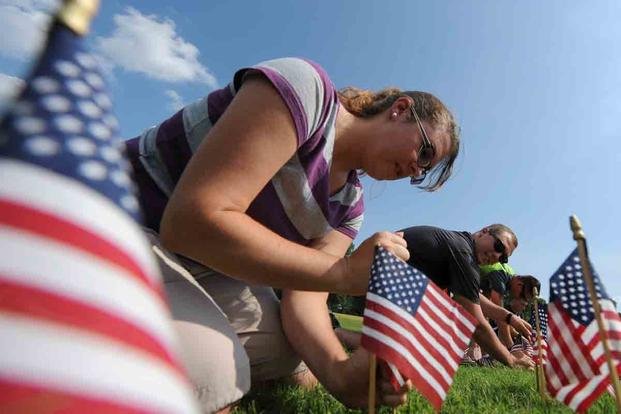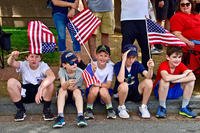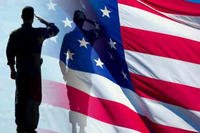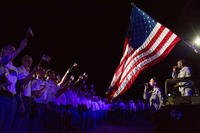The rules for handling and displaying the U.S. Flag are defined by a law known as the U.S. Flag Code. We have excerpted the federal regulations here without any changes so you can find the facts here.
The following is the text of the found in United States Code Title 4 Chapter 1.
§1. Flag; stripes and stars on
The flag of the United States shall be thirteen horizontal stripes, alternate red and white; and the union of the flag shall be forty-eight stars, white in a blue field.
§2. Same; additional stars
On the admission of a new State into the Union one star shall be added to the union of the flag; and such addition shall take effect on the fourth day of July then next succeeding such admission.
§3. Use of flag for advertising purposes; mutilation of flag
Any person who, within the District of Columbia, in any manner, for exhibition or display, shall place or cause to be placed any word, figure, mark, picture, design, drawing, or any advertisement of any nature upon any flag, standard, colors, or ensign of the United States of America; or shall expose or cause to be exposed to public view any such flag, standard, colors, or ensign upon which shall have been printed, painted, or otherwise placed, or to which shall be attached, appended, affixed, or annexed any word, figure, mark, picture, design, or drawing, or any advertisement of any nature; or who, within the District of Columbia, shall manufacture, sell, expose for sale, or to public view, or give away or have in possession for sale, or to be given away or for use for any purpose, any article or substance being an article of merchandise, or a receptacle for merchandise or article or thing for carrying or transporting merchandise, upon which shall have been printed, painted, attached, or otherwise placed a representation of any such flag, standard, colors, or ensign, to advertise, call attention to, decorate, mark, or distinguish the article or substance on which so placed shall be deemed guilty of a misdemeanor and shall be punished by a fine not exceeding $100 or by imprisonment for not more than thirty days, or both, in the discretion of the court. The words "flag, standard, colors, or ensign", as used herein, shall include any flag, standard, colors, ensign, or any picture or representation of either, or of any part or parts of either, made of any substance or represented on any substance, of any size evidently purporting to be either of said flag, standard, colors, or ensign of the United States of America or a picture or a representation of either, upon which shall be shown the colors, the stars and the stripes, in any number of either thereof, or of any part or parts of either, by which the average person seeing the same without deliberation may believe the same to represent the flag, colors, standard, or ensign of the United States of America.
§4. Pledge of allegiance to the flag; manner of delivery
The Pledge of Allegiance to the Flag: "I pledge allegiance to the Flag of the United States of America, and to the Republic for which it stands, one Nation under God, indivisible, with liberty and justice for all.", should be rendered by standing at attention facing the flag with the right hand over the heart. When not in uniform men should remove any non-religious headdress with their right hand and hold it at the left shoulder, the hand being over the heart. Persons in uniform should remain silent, face the flag, and render the military salute. Members of the Armed Forces not in uniform and veterans may render the military salute in the manner provided for persons in uniform.
§5. Display and use of flag by civilians; codification of rules and customs; definition
The following codification of existing rules and customs pertaining to the display and use of the flag of the United States of America is established for the use of such civilians or civilian groups or organizations as may not be required to conform with regulations promulgated by one or more executive departments of the Government of the United States. The flag of the United States for the purpose of this chapter shall be defined according to sections 1 and 2 of this title and Executive Order 10834 issued pursuant thereto.
§6. Time and occasions for display
(a) It is the universal custom to display the flag only from sunrise to sunset on buildings and on stationary flagstaffs in the open. However, when a patriotic effect is desired, the flag may be displayed 24 hours a day if properly illuminated during the hours of darkness.
(b) The flag should be hoisted briskly and lowered ceremoniously.
(c) The flag should not be displayed on days when the weather is inclement, except when an all weather flag is displayed.
(d) The flag should be displayed on all days, especially on New Year's Day, January 1; Inauguration Day, January 20; Martin Luther King Jr.'s birthday, third Monday in January; Lincoln's Birthday, February 12; Washington's Birthday, third Monday in February; National Vietnam War Veterans Day, March 29; Easter Sunday (variable); Mother's Day, second Sunday in May; Armed Forces Day, third Saturday in May; Memorial Day (half-staff until noon), the last Monday in May; Flag Day, June 14; Father's Day, third Sunday in June; Independence Day, July 4; National Korean War Veterans Armistice Day, July 27; Labor Day, first Monday in September; Constitution Day, September 17; Columbus Day, second Monday in October; Navy Day, October 27; Veterans Day, November 11; Thanksgiving Day, fourth Thursday in November; Christmas Day, December 25; and such other days as may be proclaimed by the President of the United States; the birthdays of States (date of admission); and on State holidays.
(e) The flag should be displayed daily on or near the main administration building of every public institution.
(f) The flag should be displayed in or near every polling place on election days.
(g) The flag should be displayed during school days in or near every schoolhouse.
§7. Position and manner of display
The flag, when carried in a procession with another flag or flags, should be either on the marching right; that is, the flag's own right, or, if there is a line of other flags, in front of the center of that line.
(a) The flag should not be displayed on a float in a parade except from a staff, or as provided in subsection (i) of this section.
(b) The flag should not be draped over the hood, top, sides, or back of a vehicle or of a railroad train or a boat. When the flag is displayed on a motorcar, the staff shall be fixed firmly to the chassis or clamped to the right fender.
(c) No other flag or pennant should be placed above or, if on the same level, to the right of the flag of the United States of America, except during church services conducted by naval chaplains at sea, when the church pennant may be flown above the flag during church services for the personnel of the Navy. No person shall display the flag of the United Nations or any other national or international flag equal, above, or in a position of superior prominence or honor to, or in place of, the flag of the United States at any place within the United States or any Territory or possession thereof: Provided, That nothing in this section shall make unlawful the continuance of the practice heretofore followed of displaying the flag of the United Nations in a position of superior prominence or honor, and other national flags in positions of equal prominence or honor, with that of the flag of the United States at the headquarters of the United Nations.
(d) The flag of the United States of America, when it is displayed with another flag against a wall from crossed staffs, should be on the right, the flag's own right, and its staff should be in front of the staff of the other flag.
(e) The flag of the United States of America should be at the center and at the highest point of the group when a number of flags of States or localities or pennants of societies are grouped and displayed from staffs.
(f) When flags of States, cities, or localities, or pennants of societies are flown on the same halyard with the flag of the United States, the latter should always be at the peak. When the flags are flown from adjacent staffs, the flag of the United States should be hoisted first and lowered last. No such flag or pennant may be placed above the flag of the United States or to the United States flag's right.
(g) When flags of two or more nations are displayed, they are to be flown from separate staffs of the same height. The flags should be of approximately equal size. International usage forbids the display of the flag of one nation above that of another nation in time of peace.
(h) When the flag of the United States is displayed from a staff projecting horizontally or at an angle from the window sill, balcony, or front of a building, the union of the flag should be placed at the peak of the staff unless the flag is at half-staff. When the flag is suspended over a sidewalk from a rope extending from a house to a pole at the edge of the sidewalk, the flag should be hoisted out, union first, from the building.
(i) When displayed either horizontally or vertically against a wall, the union should be uppermost and to the flag's own right, that is, to the observer's left. When displayed in a window, the flag should be displayed in the same way, with the union or blue field to the left of the observer in the street.
(j) When the flag is displayed over the middle of the street, it should be suspended vertically with the union to the north in an east and west street or to the east in a north and south street.
(k) When used on a speaker's platform, the flag, if displayed flat, should be displayed above and behind the speaker. When displayed from a staff in a church or public auditorium, the flag of the United States of America should hold the position of superior prominence, in advance of the audience, and in the position of honor at the clergyman's or speaker's right as he faces the audience. Any other flag so displayed should be placed on the left of the clergyman or speaker or to the right of the audience.
(l) The flag should form a distinctive feature of the ceremony of unveiling a statue or monument, but it should never be used as the covering for the statue or monument.
(m) The flag, when flown at half-staff, should be first hoisted to the peak for an instant and then lowered to the half-staff position. The flag should be again raised to the peak before it is lowered for the day. On Memorial Day the flag should be displayed at half-staff until noon only, then raised to the top of the staff. By order of the President, the flag shall be flown at half-staff upon the death of principal figures of the United States Government and the Governor of a State, territory, or possession, as a mark of respect to their memory. In the event of the death of other officials or foreign dignitaries, the flag is to be displayed at half-staff according to Presidential instructions or orders, or in accordance with recognized customs or practices not inconsistent with law. In the event of the death of a present or former official of the government of any State, territory, or possession of the United States, the death of a member of the Armed Forces from any State, territory, or possession who dies while serving on active duty, or the death of a first responder working in any State, territory, or possession who dies while serving in the line of duty, the Governor of that State, territory, or possession may proclaim that the National flag shall be flown at half-staff, and the same authority is provided to the Mayor of the District of Columbia with respect to present or former officials of the District of Columbia, members of the Armed Forces from the District of Columbia, and first responders working in the District of Columbia. When the Governor of a State, territory, or possession, or the Mayor of the District of Columbia, issues a proclamation under the preceding sentence that the National flag be flown at half-staff in that State, territory, or possession or in the District of Columbia because of the death of a member of the Armed Forces, the National flag flown at any Federal installation or facility in the area covered by that proclamation shall be flown at half-staff consistent with that proclamation. The flag shall be flown at half-staff 30 days from the death of the President or a former President; 10 days from the day of death of the Vice President, the Chief Justice or a retired Chief Justice of the United States, or the Speaker of the House of Representatives; from the day of death until interment of an Associate Justice of the Supreme Court, a Secretary of an executive or military department, a former Vice President, or the Governor of a State, territory, or possession; and on the day of death and the following day for a Member of Congress. The flag shall be flown at half-staff on Peace Officers Memorial Day, unless that day is also Armed Forces Day. As used in this subsection—
(1) the term "half-staff" means the position of the flag when it is one-half the distance between the top and bottom of the staff;
(2) the term "executive or military department" means any agency listed under sections 101 and 102 of title 5;
(3) the term "Member of Congress" means a Senator, a Representative, a Delegate, or the Resident Commissioner from Puerto Rico; and
(4) the term "first responder" means a "public safety officer" as defined in section 1204 of title I of the Omnibus Crime Control and Safe Streets Act of 1968 (34 U.S.C. 10284).
(n) When the flag is used to cover a casket, it should be so placed that the union is at the head and over the left shoulder. The flag should not be lowered into the grave or allowed to touch the ground.
(o) When the flag is suspended across a corridor or lobby in a building with only one main entrance, it should be suspended vertically with the union of the flag to the observer's left upon entering. If the building has more than one main entrance, the flag should be suspended vertically near the center of the corridor or lobby with the union to the north, when entrances are to the east and west or to the east when entrances are to the north and south. If there are entrances in more than two directions, the union should be to the east.
§8. Respect for flag
No disrespect should be shown to the flag of the United States of America; the flag should not be dipped to any person or thing. Regimental colors, State flags, and organization or institutional flags are to be dipped as a mark of honor.
(a) The flag should never be displayed with the union down, except as a signal of dire distress in instances of extreme danger to life or property.
(b) The flag should never touch anything beneath it, such as the ground, the floor, water, or merchandise.
(c) The flag should never be carried flat or horizontally, but always aloft and free.
(d) The flag should never be used as wearing apparel, bedding, or drapery. It should never be festooned, drawn back, nor up, in folds, but always allowed to fall free. Bunting of blue, white, and red, always arranged with the blue above, the white in the middle, and the red below, should be used for covering a speaker's desk, draping the front of the platform, and for decoration in general.
(e) The flag should never be fastened, displayed, used, or stored in such a manner as to permit it to be easily torn, soiled, or damaged in any way.
(f) The flag should never be used as a covering for a ceiling.
(g) The flag should never have placed upon it, nor on any part of it, nor attached to it any mark, insignia, letter, word, figure, design, picture, or drawing of any nature.
(h) The flag should never be used as a receptacle for receiving, holding, carrying, or delivering anything.
(i) The flag should never be used for advertising purposes in any manner whatsoever. It should not be embroidered on such articles as cushions or handkerchiefs and the like, printed or otherwise impressed on paper napkins or boxes or anything that is designed for temporary use and discard. Advertising signs should not be fastened to a staff or halyard from which the flag is flown.
(j) No part of the flag should ever be used as a costume or athletic uniform. However, a flag patch may be affixed to the uniform of military personnel, firemen, policemen, and members of patriotic organizations. The flag represents a living country and is itself considered a living thing. Therefore, the lapel flag pin being a replica, should be worn on the left lapel near the heart.
(k) The flag, when it is in such condition that it is no longer a fitting emblem for display, should be destroyed in a dignified way, preferably by burning.
§9. Conduct during hoisting, lowering or passing of flag
During the ceremony of hoisting or lowering the flag or when the flag is passing in a parade or in review, all persons present in uniform should render the military salute. Members of the Armed Forces and veterans who are present but not in uniform may render the military salute. All other persons present should face the flag and stand at attention with their right hand over the heart, or if applicable, remove their headdress with their right hand and hold it at the left shoulder, the hand being over the heart. Citizens of other countries present should stand at attention. All such conduct toward the flag in a moving column should be rendered at the moment the flag passes.
§10. Modification of rules and customs by President
Any rule or custom pertaining to the display of the flag of the United States of America, set forth herein, may be altered, modified, or repealed, or additional rules with respect thereto may be prescribed, by the Commander in Chief of the Armed Forces of the United States, whenever he deems it to be appropriate or desirable; and any such alteration or additional rule shall be set forth in a proclamation.
Want to Know More About the U.S. Military?
Be sure to get the latest news about the U.S. Military, as well as critical info about how to join and all the benefits of service. Subscribe to Military.com and receive customized updates delivered straight to your inbox.











